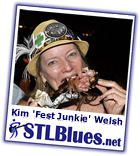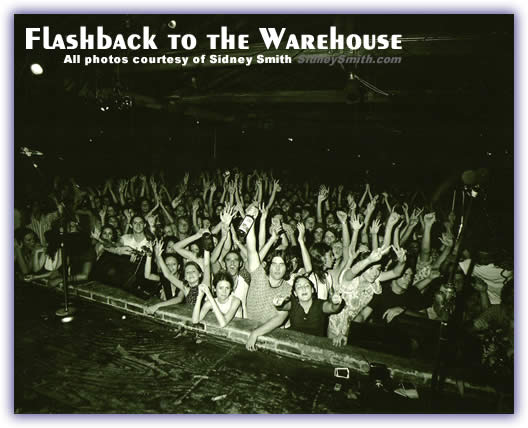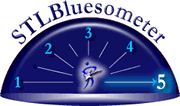| Flashback to the Warehouse |
 By
Kim "Fest Junkie" Welsh By
Kim "Fest Junkie" Welsh
Muddy Waters nailed it in his song, “The Blues had a Baby and they named it Rock-and-Roll.” We all know rock was born from those low-down blues we love so much and many of our rock heroes such as The Beatles, Stevie Ray Vaughan, Eric Clapton, and the Rolling Stones were heavily influenced by our blues legends. Many rock songs are nothing more than old blues songs with  an electrified sound and a heavy beat. an electrified sound and a heavy beat.
Many of these rock Gods didn’t call their music “rock-and-roll,” a term that was originally black slang for… ahem… making love. Eric Clapton considered himself a Chicago-style blues musician; The Beatles originally played rhythm and blues. The Chicago blues scene swayed 1960’s rockers and Howlin’ Wolf, Muddy Waters, and Willie Dixon songs were recorded by everyone from Jimi Hendrix to Led Zeppelin to The Doors. So, fellow blues travelers, let’s flashback to the heyday of rock music in New Orleans in the 1970’s…
The Warehouse was THE rock venue of New Orleans and in many ways it was a house of the rising sun. It was located at 1820 Tchoupitoulas Street on the bank of the muddy Mississippi River. It began as a cotton warehouse in the 1850s and was not heated or air conditioned but could hold slightly over 3000 people legally. It opened on January 30, 1970 with Fleetwood Mac playing on Friday night and the Grateful Dead playing on Saturday night. The Dead were arrested after the show in their hotel for minor possession of weed which would be immortalized in their song, “Truckin.’” One of the few existing press photos of Owsley, the Dead’s sound engineer, ran on the cover of the New Orleans local newspaper, The Times Picayune, with the headline “Acid King Nabbed”. The band stayed totally clean at the hotel after being warned by the Jefferson Airplane about Clarence Giarusso’s NOPD narcotics squad. Set up “like a bowling pin” indeed. The Dead did not come back to perform in New Orleans for twelve years.
Back then, there wasn’t a big tour machine backed by record companies. The Warehouse was a jumping off point to go from Fillmore to Fillmore in a half circle of venues that started in New York, to Atlanta, to the Warehouse, sometimes to Memphis, to Houston, and then to San Francisco.
Among the many bands who played there, the Warehouse hosted the greats and soon-to-be-greats including Bob Marley (who never played anywhere but the Warehouse in New Orleans,) Chicago, ZZ Top, Pink Floyd, Yes, Emerson, Lake, and Palmer, Kiss, Rush, Blue Oyster Cult (in white sequin tuxedos,) Leon Russell, Deep Purple, Foghat, J. Geils Band, Aerosmith, Jeff Beck, Joe Cocker, Alice Cooper, Grand Funk Railroad, Tom Petty, Eric Clapton, Carlos Santana, Bruce Springsteen, Rod Stewart, Ted Nugent, Steve Winwood, Frank Zappa, Wishbone Ash, Johnny and Edgar Winter, Uriah Heep, The Clash, David Bowie, Elton John, the Eagles, Jethro Tull, Styx, Humble Pie, Robin Trower, Golden Earring, Peter Frampton, Cream, Marshall Tucker, and Charlie Daniels. Jim Morrison’s last concert with The Doors was at the Warehouse on December 12, 1970. Rock history was made there! Where else could you see such talented legends for $5? In the early 70s, admission was free if you brought a carpet remnant!
The Allman Brothers was their “house band” and played about twice a month from 1970 to 1975. They played three New Year’s Eve shows. One evening after a show, their roadie Red Dog, and several band members were arrested for possession. When they got out of jail, they did what they traditionally did many mornings after the show… they went to Audubon Park and played for free!
In 1970, Pink Floyd brought their quadraphonic sound system, which allowed them to direct where the sound was coming from in the Warehouse. Attendees marveled at how the sound seemed to come from the roof and all around. Their truck with all their equipment was stolen and mysteriously reappeared after the band’s management paid a “finder’s fee” to the one of the NOPD police union’s slush funds. This happened after they had already cancelled the rest of the US tour. There is a picture of the truck and gear on the back of the Ummagumma album cover. Pink Floyd didn’t return to New Orleans until 1994, 24 years later.
The Warehouse was so much more than just a music venue. It had a pulse, a scene, a culture. It continues to have a following of people who enjoy reminiscing about the golden years of the 1970s. They often had shows Wednesday through Sunday nights and when not booked for music they had organic food lectures, women’s birthing and Lamaze classes, healthy food discussions, and other offerings to the hippies of the day.
Sidney Smith, who supplied the wonderful images for this article told me, “The Warehouse was the Fillmore East of the South and I was the primary photographer. At 16 years old, with camera in hand, I became the official, unofficial lensman for the Warehouse. By the time I was 20, I had amassed a photographic collection of rock royalty including the Allman Brothers, Grateful Dead, Led Zeppelin, Rolling Stones, The Who, Paul McCartney, George Harrison, Bruce Springsteen, Bob Dylan, and so many more.”
Further, Sidney stated, “The Warehouse meant so much to so many people. It opened during a period of time when having long hair actually meant something. There was a feeling of kinship and brotherhood within the walls of the old building. Music wailed from within. Johnny Winter, David Bowie, B.B. King, Cat Stevens, Jeff Beck, The Doors…all played the Warehouse. Fans who pressed up against the stage were just inches from their heroes…a rarity today.”
According to Ross Perimutter, stage manager at the Warehouse in 1977-78, Little Feat has a song on the “Let it Roll” CD called “Hanging on to the Good Times” (a really nice tribute to Lowell George) that references a particularly memorable gig at the Warehouse.
The lyrics read:
“And I just have to laugh
When I recall the time down in New Orleans
Don’t ya know
Rained us out of an indoor show
We spent our money so fine
The girls were standin’ in line
Down in the Quarters at Lucky Pierre’s
A time of our life without any cares…”
The short story is that it was raining like crazy and Tchoupitoulas Street started flooding. Everyone inside was completely oblivious to what was happening outside and suddenly the loading doors burst open and a huge 2-foot tsunami rolled in over the crowd. People were literally swimming for the exits and the roadies were diving to yank the power to the stage…a “rained out gig” at an indoor show!
I personally went to the Warehouse when I was in junior high school through college. I lived two hours away from New Orleans but at the drop of a hat I would throw my books into the corner with a kiss and a promise, slither into my tattered, embroidered jeans, huarache “Jesus” sandals with tire tread sole, tie-dye smock with a “tube top” under it so I could take off my shirt in the sweltering heat of the Warehouse. We would load up in our 1969 Firebird, put in a jammin’ 8-track, and fly to the Crescent City to hear our guitar Gods play.
To be honest, much of it is rather hazy now, but the concert that left the biggest impression on me was the Uriah Heep and Wishbone Ash concert of 1972. We spent many an afternoon listening to these two bands on my stereo with the huge speakers in my parent’s living room when we should have been doing our homework. We had looked forward to that weekend, saved money for gas, food, and a hotel room, made “Jungle Juice” from whatever alcohol and juice we could get our hands on, and finally we made it to the sketchy Uptown neighborhood where we parked. My boyfriend found a young man on a porch nearby and gave him a few bucks to “keep an eye on our car.” He promised a few more bucks if it was intact when we returned and we walked toward the river. We seated ourselves on the floor on the carpet remnants in front of the stage. Soon the crowd gathered all around us with their patchouli scented tie-dye clothing, “elephant bell-bottom” low-riding, skin-tight pants, peace signs, wide belts, and bells around their ankles. You could get high just breathing the air but everyone was always willing to share.
I never witnessed a fight or any negative vibes there. The Warehouse was packed with hippie rockers enjoying the trippy mythical songs, complete with guitar jams galore by Mr. Party himself, Mick Box. It was a place where we were free to be true hippies, if only for the weekend, because such attire and attitudes were frowned on back home in “Hattiesgulch, U.S.A.” Besides the music was the “people show.” There were bikers and their ol’ ladies and long-hairs from all over, trippers examining their fingers as if they were aliens that just fell from space, and old and young beatnicks and hippies! The air was so full of sweet smoke that you could wave your hands through it and watch it swirl. It truly was a special place with an awesome vibe.
Wishbone Ash was one of England’s most popular hard rock bands in the early 70s and their third album, “Argus,” was released in 1972 featuring the classic line up of Andy Powell on guitar (Gibson Flying V) and vocals, Ted Turner on guitar (Fender Strat) and vocals, Martin Turner on bass and vocals, and Steve Upton on drums. “Argus” was voted album of the year by a few British music magazines. Wishbone Ash had an uncanny ability to weave their guitars together in a fashion that none of us had ever heard before. The performance at the Warehouse ranged from “Handy,” best described as psychedelic jazz to “Phoenix,” their show-stopping hard rock masterpiece.
Uriah Heep was another English rock band formed in 1969 by producer Gerry Bron featuring vocalist David Byron, multi-instrumentalist Ken Hensley (often called the Phantom of the Rock ‘n Roll Opera with his outrageous antics using organs and Moog synthesizers,) guitarists Mick Box and Paul Newton, with Nigel Olsson on drums. In 1971, they had an album titled “Look at Yourself” which was followed in 1972 with “Demons and Wizards,” and “The Magician’s Birthday,” their first foray into the lyrical realm of dungeons, dragons, and fantasy tales. This was a time when universally acknowledged gods of heavy metal such as Led Zeppelin and Black Sabbath were visiting various fantasy realms lyrically on virtually every song. “Demons and Wizards” reached number 20 in the British charts, but, more importantly, was the first of five consecutive albums to go top 40 in the massive selling American charts with hits including “Stealin’” and “Easy Livin.’” This is true classic and progressive hard rock though under-rated and relatively unknown by many today.
The Talking Heads performed at the Warehouse on closing night, September 10, 1982. The Warehouse was demolished in April of 1989. Several fans have had their ashes spread over the area where the Warehouse once stood. It is indeed sacred ground.
All photos courtesy of Sidney Smith. These images and many more are available at www.sidneysmithphotos.com
 |
|
Enjoy
the image gallery of the Flashback
Click on buttons below, drag the thumbnail panel
where you want, and enjoy the show! |
|
|

